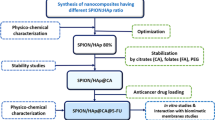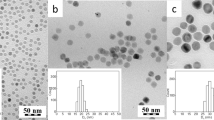Abstract
The aim of this study was to determine the biocompatibility and potential toxicity of apatite-coated magnetite nanoparticles. The in vitro biocompatibility with human red blood cells was evaluated, not hemolytic effects were found at concentrations lower than 3 mg/ml. For the in vivo study, Balb/c mice were used. The animals were injected intravenously or intraperitoneally, the doses ranged from 100 to 2,500 mg/Kg. All the injected animals showed normal kidney and liver function. No significant changes were found in the body weight, the organs weight and the iron levels in liver due to the administration. In conclusion, apatite-coated magnetite nanoparticles did not induce any abnormal clinical signs in the laboratory animals. The results demonstrated that apatite-coated magnetite nanoparticles of 8 ± 2 nm in size did not have hemolytic effect in human erythrocytes and did not cause apparent toxicity in Balb/c mice under the experimental conditions of this study.





Similar content being viewed by others
References
Tartaj P. Nanomagnets-from fundamental physics to biomedicine. Curr Nano Sci. 2006;2:43–53.
Corot C. Recent advances in iron oxide nanocrystal technology for medical imaging. Adv Drug Deliver Rev. 2006;58:1471–504.
Gonzalez-Fernandez MA, Torres TE, Andrés-Vergés M, Costo R, De la Presa P, Serna CJ, Morales MP, Marquina C, Ibarra MR, Goya GF. Magnetic nanoparticles for power absorption: optimizing size, shape and magnetic properties. J Solid State Chem. 2009;182:2779–84.
Neuberger T, Schöpf B, Hofmann H, Hofmann M, Von Rechenberg B. Superparamagnetic nanoparticles for biomedical applications: possibilities and limitations of a new drug delivery system. J Magn Magn Mat. 2005;293:483–96.
Dobrovolskaia MA, Aggarwal P, Hall JB, McNeil SE. Preclinical studies to understand nanoparticle interaction with the immune system and its potential effects on nanoparticle biodistribution. Mol Pharmacol. 2008;5:487–95.
Hanson S, Lalor PA, Niemi SM, Northup SJ, Ratner BD, Spector M, Vale BH, Willson JE. Testing biomaterials. In: Ratner BD, Hoffman AS, Schoen FJ, Lemons JE, editors. Biomaterials Science. An introduction to materials in medicine. San Diego: Academic Press; 1996. p. 215.
Klaassen CD, Watkins JB. Basics of toxicology. Madrid: McGraw-Hill; 2005. p. 560.
Múzquiz-Ramos EM, Cortés-Hernández DA, Escobedo-Bocardo J. Biomimetic apatite coating on magnetite particles. Mat Lett. 2010;64:1117–9.
Betancourt R, Ayala O, García LA, Rodríguez O, Matutes J, Ramos G, Yee H. Synthesis and magneto-structural study of CoxFe3−xO4 nanoparticles. J Magn Magn Mat. 2005;294:33–6.
Martínez A, Izquierdo I, Vallet M. Bioactivity of a CaO–SiO2 binary glasses system. Chem Mater. 2000;12:3080–8.
Kokubo T, Kushitani H, Sakka S. Solutions able to reproduce in vivo surface-structure changes in bioactive glass-ceramic A-W. J Biomater Res. 1990;24:721–34.
NCL Method ITA-1: Analysis of hemolytic properties of nanoparticles.Nanotechnology characterization laboratory. National Cancer Institute-Frederick. http://ncl.cancer.gov/NCL_Method_ITA-1.pdf. (2009) Accessed 27 April 2011.
ASTM F-756. Standard practice for assessment of hemolytic properties of materials, 2009, annual book of ASTM standars. Committee F04 medical and surgical materials and devices, subcommittee F04.16 biocompatibility test methods. Philadelphia: American Society for Testing and Materials; 2009.
Mexican Official Standard NOM-062-ZOO-1999. http://www.economia-noms.gob.mx/ Accessed 12 Dec 2010.
Pereira MC, Pereira ML, Sousa JP. Histological effects of iron accumulation on mice liver and spleen after administration of a metallic solution. Biomaterials. 1999;20:2193–8.
Okuda M, Takeguchi M, Ruairc O, Tagaya M, Zhu Y, Hashimoto A, Hanagata N, Schmitt W, Ikoma T. Structural analysis of hydroxyapatite coating on magnetite nanoparticles using energy filter imaging and electron tomography. J Electron Microsc. 2010;59:173–9.
Bretcanu O, Spriano S, Brovarone C, Verne E. Synthesis and characterization of coprecipitation-derived ferromagnetic glass-ceramic. J Mater Sci. 2006;41:1029–37.
Kim DH, Nikles DE, Johnson DT, Brazel CS. Heat generation of aqueously dispersed CoFe2O4 nanoparticles as heating agents for magnetically activated drug delivery and hyperthermia. J Mag Magn Mat. 2008;320:2390–6.
Wang ZY, Song J, Zhang DS. Nanosized As2O3/Fe2O3 complexes combined with magnetic fluid hyperthermia selectively target liver cancer cells. World J Gastroenterol. 2009;15:2995–3002.
Haidar ZS, Hamdy RC, Tabrizian M. Biocompatibility and safety of a hybrid core-shell nanoparticulate OP-1 delivery system intramuscularly administered in rats. Biomaterials. 2010;31:2746–54.
Jain TK, Reddy MK, Morales MA, Leslie-Pelecky DL, Labhasetwar V. Biodistribution, clearance, and biocompatibility of iron oxide magnetic nanoparticles in rats. Mol Pharm. 2007;5:316–27.
Pankhurst QA, Connolly J, Jones SK, Dobson J. Applications of magnetic nanoparticles in biomedicine. J Phys D. 2003;36:167–81.
Author information
Authors and Affiliations
Corresponding author
Rights and permissions
About this article
Cite this article
Múzquiz-Ramos, E.M., Cortés-Hernández, D.A., Escobedo-Bocardo, J.C. et al. In vitro and in vivo biocompatibility of apatite-coated magnetite nanoparticles for cancer therapy. J Mater Sci: Mater Med 24, 1035–1041 (2013). https://doi.org/10.1007/s10856-013-4862-0
Received:
Accepted:
Published:
Issue Date:
DOI: https://doi.org/10.1007/s10856-013-4862-0




